In the trailer, Omegaland (Jonas & Verena Kyratzes, 2017) looks like nothing special. Well, it looks like a nothing special Super Mario Bros. (Nintendo, 1985) clone. But knowing the Kyratzes back catalogue, what the trailer didn’t say intrigued me more. It didn’t say why you should play this game. It didn’t say what it did different. It did nothing to really encourage you play it.
And, as you might expect in our postindieapocalyptic landscape, it didn’t really do big business and I don’t think I’ve seen it garner any attention on gaming websites. It’s difficult to share: uh, look, here’s a trailer from the acclaimed Kyratzes stable! It shows a brilliantly derivative game! More derivative than any other derivative game has gone before!
Oh of course there’s more to Omegaland than a Super Mario clone. It feels a bit Pippin Barr, but really long. A bit too long.
It’s not earth-shattering and you’re not missing out on the Mona Lisa of Games. But what are you missing? Why did I struggle with it? And why do I think the ending was the best bit?
I didn’t want to play Omegaland because, look, I don’t get that whole Mario thing. It’s like when people get their brainfreak on about the latest Zelda game and I’m just what is zelda. When Super Mario Bros. was released, I was still devoted to my Atari 8-bit computer and it took quite a few years before I finally got with the console programme – and bought into the Sega Mega Drive through Sonic the Hedgehog (Sonic Team, 1991).
There actually was a Super Mario clone on the Atari called Bros and I played it although ignorant of the source material. I liked the game at the time but could never get very far because it was punishing for all the wrong reasons.
Mario has never been my touchstone. When someone drops a cute Mario reference into a game it usually goes right over my head. At the time I played, that bit in Braid where the dinosaur dude pops out and says the princess is in another castle just seemed weird. I had no idea that Braid (Number None, 2008) was deliberately channelling memories of Super Mario Bros. throughout.
I’ve discovered I have no love for the “jumping on heads” mechanic. It’s not that I don’t love platformers because my father and I spent far too many hours ploughing through Miner 2049’er (Big Five Software, 1982) during the Atari years, which was game of the year material back then. I also remember the thrill of watching my father play Space Panic (Universal, 1980); we often used to talk about the wacky sounds made by the cabinet – from the creatures climbing out of the pits you’d dug for them, to the jolt when one of the monsters caught you for dinner. Without the blasting reverb of an already busted 80s cabinet speaker, it sounds way too genteel through MAME.
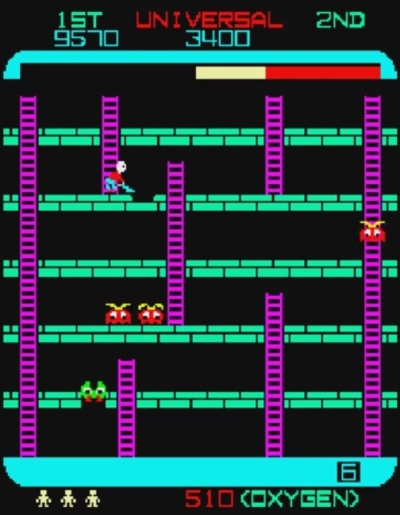
Lacking Mario in my past, I don’t seem to care about putting Mario in my future. I often think of “jumping on heads” as a cheap mechanic rather than iconic or nostalgic and I only recently realised this was partly the reason I had problems digging FREEDOM: Diegesis (Quicksand Games, 2016) which I related in February’s newsletter. And there’s spikes, of course. There are always spikes.
Thus, when it came to Omegaland, I found it a terrible slog. I hated that Marioesque jump and having to land on dudes’ heads. There was only so much I could take in a single session. There were also a handful of levels which seemed frustrating rather than challenging which brought me to the edge of the ragequit abyss. And, my God, it seemed so long. How long would it take me to retrieve all the damn keys to unlock Castle Omega? To reach the literal Omega of this game? Why am I playing something I don’t enjoy?
Because I knew there must be more. It’s too obvious, it’s too simple otherwise. There has to be more behind the door. The name suggested a relationship to Alphaland (Jonas Kyratzes & Terry Cavanagh, 2011) in which a simple, unfinished platformer gives way to an exploration through… well, perhaps that’s an exercise better left to the reader. Alphaland has a lot in common with Standard Bits (doomlaser, 2007) which is an even more abstract and more complex exploration game; think of it as Adventure (Warren Robinett, 1980) on the Atari 2600, but deliberately broken without win conditions.

Both Alphaland and Standard Bits get to the point quickly. Omegaland took an awful long time getting to somewhere interesting and it seemed to have no relationship with Alphaland other than name… until you collect all the keys and give them to the princess.
<<<< spoilerzzzz >>>>
It shouldn’t surprise that Kyratzes has no time for stories about trusting a monarchy to do the right thing; you might as well trust rich folk based on the modern parables found in the Gospels According to St. Tony Stark and St. Bruce Wayne. Omegaland’s princess snatches the keys from you, aquiring unfettered access to the “Tools of Development” with which she reshapes the world into something nightmarish. With all this power, her petulance is given form. The green spaces and blue skies are corrupted into a black, glitched landscape and those who survived this apocalypse huddle in refugee camps.
Thus begins the quest to the take back the “Tools of Development” for the people and the slow, uncomfortable realisation I wasn’t even halfway through the game. To be fair, the glitch incarnation of Omegaland is a lot more interesting and it occurred to me that FREEDOM: Diegesis was kin. Although I’d found FREEDOM frustrating, its corrupted reality compelled me to keep going. Omegaland was far less brutal though, just a lot longer than the idea needed to be.
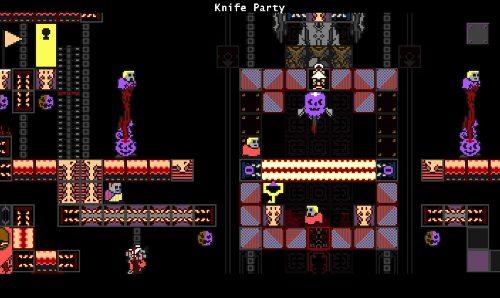
Many of the levels in Omegaland are so spacious and open that you seldom feel you have fully explored them, particularly the more hazardous glitch levels. Occasionally I went above and beyond the call of critical duty to reach some esoteric locations. It wasn’t the scent of reward that made me seek out these secret locations but my calling as an explorer of videogame wilderness.

Jonas Kyratzes is trying to do two things with Omegaland. First, he’s spinning a little story about how power should be for all and not just a special select few, regardless of how they earned it. I’m pretty sure if you carefully rearranged the letters of “Tools of Development” you’d eventually end up with “means of production”.
Kyratzes’ second goal is to celebrate the flood of platform games that came to define the early indie years, unpolished and naked in their inspirations.
“When working on Omegaland,” wrote Kyratzes, “I wasn’t mainly thinking about Super Mario, although Super Mario Land 2 was definitely an influence. Rather, I was thinking about the many odd little platform games I played over the years, some of them made long before indie games were a thing.”
But it was one other nuance of Omegaland that I found special, making it more memorable than I expected.
In action stories, life is only interesting to the audience when something bad is happening. Before our heroes take on the great evil, nothing of note is happening. The heroes need evil to define them, give them something to do. Without the Terminator, there is no Sarah Connor. Without Dracula, Van Helsing is just some guy. The heroes’ terrible secret is that evil keeps them employed.
And when evil is vanquished, the heroes become nobodies. The audience puts the book down and that universe, forged by a battle between good and evil, perishes. (Unless it’s a series in which the author keeps conjuring new bad guys to resuscitate the heroes from their literary graves.)
Traditionally, games have replicated this condition. Games have allowed themselves to become defined by challenge, by something to fight. And when a player defeats that challenge, the game disintegrates. Sure, you can replay just like you can watch a movie again. But the game stops when the challenge ends.
In Omegaland, once you’ve retrieved the Tools of Development and the princess has been executed in front of a cheering crowd, the game does not stop. The whole map is free to explore again and the land previously called “The Flower Kingdom” becomes “The Flower Republic”. While everything has returned to normal, the people are using the Tools of Development to make things safer and better than they were before… and you can see this for yourself.
I was stunned how much there was to see after beating the game, completely devoid of challenge. Indeed, so much to see that I didn’t exhaust it. I became a tourist of the new republic and felt no need to see everything.
“Omega” usually connotes the end of things, but Omegaland does not have an end. And so Omegaland’s final trick is to subvert its own title. After evil falls, life goes on. The heroes’ tale may be over but, for everyone else, it’s just another day. Another of many more to come.
Omegaland is currently available on Steam, the tools of distribution owned by Valve.
Download my FREE eBook on the collapse of indie game prices an accessible and comprehensive explanation of what has happened to the market.
Sign up for the monthly Electron Dance Newsletter and follow on Twitter!



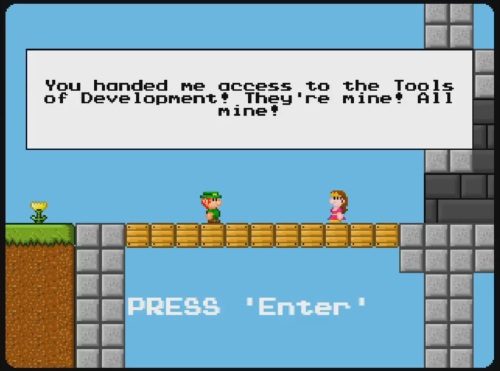

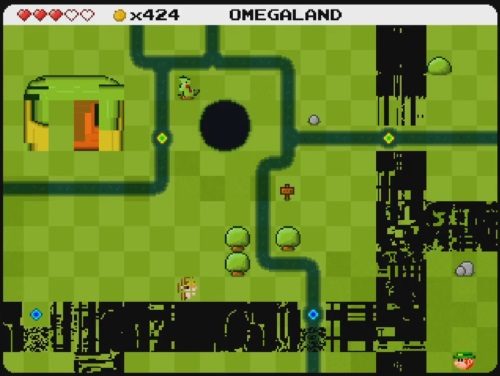
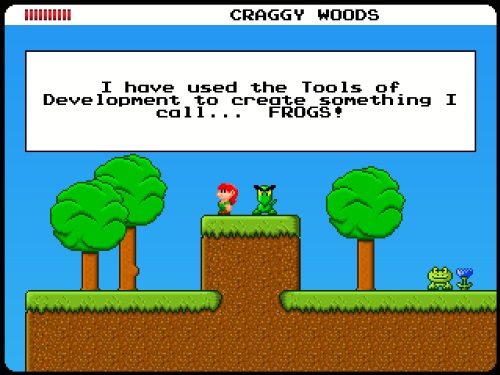
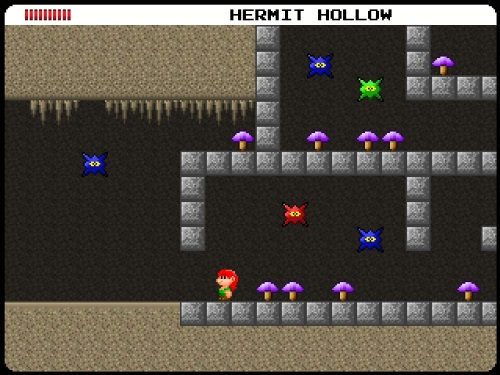






I’m sure this isn’t the only game that has an ending like this. Was it The Witcher, which I haven’t played, which told you what happened after the game finished during the credits? Although I think that was telling you stuff plus more about the consequences of your actions. Any other examples?
I can’t think of a single game with an ending where the world becomes peaceful and you actually get to experience it indepth yourself. I played the new zelda game and, man, was that ending disappointing.
I wish it could have been like this because wandering the world as a regular person was probably my favourite part of botw.
I mean: I can’t think of a single game *other* than this. Really didn’t mean to drag a whole other game into the conversation and completely snub the game at hand.
Omegaland’s ending sounds impossibly lovely, but I don’t know if I’ll ever find the time & effort in my life to get there.
Now I guess you can play something like GTA beyond the closing credits, but it’s not the same. The city is alive with “mission activity” when you’re playing and as you make progress, you’re effectively vacuuming up all the “life” of the game and cleaning it of missions.
There’s always something a little empty and sad when you reach the end and you can wander those empty streets, knowing they will offer you nothing new, that the world is exhausted. The world is not changed or reinterpreted through its ending. The world is dead, a memory of what transpired.
Consuming a whole game, especially one that initially tries so hard to present itself as an entire world, leaves me feeling hollow every time.
I’ve never played Earthbound, but apparently it ends with you walking home after the final battle? This thread suggests that Dragon Quest I and II do the same thing, and maybe Chrono Trigger?
Trivia:
It’s also in many ways a stealth remake of Phenomenon 32.
I always thought of the game as having an end state rather than an ending; that’s something I’ve always craved in games, and it appeared appropriate here, with revisiting familiar locations being a theme. (In this case, the end state is a republic. *g*)
The level of difficulty is such a weird thing with games like this one. To a lot of people, the beginning is a breeze, finished quickly with barely any effort. To others, it takes ages. But it was very important to me to really establish the reality of that world before shattering it. (There’s a parallel to the beginning of Babylon 5 taking a long time to make you understand its world before events start fundamentally changing it; it’s not a coincidence that one of first lines in part 2 is an NPC saying “Nothing’s the same anymore.”)
Matt – thanks for that, it does look like a few games have done this before.
Jonas, I did notice Phenomenon 32 level reset mechanic. The game remembers your health when you start a zone and if you die it resets you back to that state; so if you do badly on successive zones, the next zone you’ll be stuck with one heart of health throughout until you can find more hearts. I didn’t notice this for some time and was the cause of some frustration, thinking I had to do a level with one health. Once I twigged, I went to an easier level to “grind” my health back up (Verdant Knolls is good for this in the glitch part of the game).
I did notice the “Nothing’s the same anymore” line but I should’ve figured the B5 reference was intentional. I’m sure there are a lot of other references in there that I don’t get. There always are in a Kyratzes game!
I think I understood why the game was so extensive but, at least in my case, it just seemed to go on and on thus undermined the attempt to establish the world. Nice choices of music for the glitch zones!
So I was like “Why haven’t I played Earthbound? Everybody loves Earthbound!” and apparently there’s an emulator site for Earthbound so now I’m playing Earthbound. Will check back in a year or so to tell you about the ending.
…or not, because my save doesn’t seem to have saved. Anyone know how to make save games happen on online SNES emulators?
Was about to say ‘Earthbound lets you do this,’ so yeah, Earthbound lets you do this, I can confirm.
Definitely checking Omegaland out though!
And I think you can just save state in an emulator. Or you can get the SNES classic when that comes out if you want to play the game (good luck!)
I don’t think Chrono Trigger actually lets you tour around in the ending, but I might be remembering wrong due to many multiple endings. It’s got a very nice ending though.
The glitch levels themselves are basically Phenomenon 32 levels, complete with anomalies and drifting particles. It’s basically “what if Phenomenon 32 happened in a Super Mario clone?”
The story contains similarities too, although those are probably themes that are likely to repeat in my writing in general.
The music in the glitch levels is mostly the original songs, but put through the blender.
As usual, the game is designed to mainly appeal to my own taste. I like spacious levels, taking my time, games with plenty of content. I don’t mind a bit of grind or repetition, as long as I feel I’m moving forward and there’s fun things to find. Basically the exact opposite from today’s “streamlined” approach that so many indies love. I actually kinda enjoy playing Omegaland, despite the many hours I spent making it. There’s a risk in making something so tailored to one specific type of player, of course, but I think that is also results in games that some people really really love.
Thanks Amanda! The issue may be (1) getting the function key to behave as I want on the Mac (I think I know how to do that in theory) and (2) seeing whether the save state actually gets preserved when I close the tab and reopen it. Or I could just stop being silly and download an offline emulator instead of counting on Flash.
Matt/Amanda, maybe I should pay Earthbound too 🙂 alternatively I can just outsource that to you, Matt. After Omegaland, I’ve swapped in Future Unfolding. Time to finally finish this one!
Jonas, I didn’t spend as much time here on aspects I did like. In particular, I became extremely paranoid about climbing any glitch level into the sky, because you were sure as hell likely to attract a bunch of bugs down on your head.
Also, the difficulty curve is peculiar, it ramps up then gradually falls with upgrades. You feel extremely safe towards the end – there is little attempt to autobalance the levels against your upgrades. I appreciated that, I appreciated that the more people working together meant your job was easier, not progressively harder.
Jonas – also, lest I forget, Omegaflow was also a good reason not to climb too high 🙂
As an update, I figured out the emulator save–it turns out that the system boxes that popped up were not some weird glitch but the file loading and saving on my computer, which I should’ve figured out. It’ll be a while, though, I expect.
I’ve always thought that being able to get actually *better* in a meaningful way was the whole point of the RPG experience (and Omegaland is partially an RPG, really). This seems to have started changing in most games after Oblivion, which is baffling and sucks the joy out of a lot of RPGs for me. And yeah, it was also very important for the story. Bringing people together makes things better, makes problems that initially seem impossible to overcome actually solvable.
The Omegaflows, of course, are actually the Emissions from STALKER: Call of Pripyat. Although I came up with a similar gameplay idea in the first (unreleased) version of Phenomenon 32 before I’d ever played STALKER.
I haven’t played Omegaland but I’m intrigued. I think I’d probably gel with it more being from a Mario background.
It’s funny you mention the jumping-on-heads thing because I watched (only a few minutes of) Dean Takahashi’s ‘Shameful 26 minutes’ of Cuphead and one of the first things he does is try to jump on an enemy instead of shooting it. It’s not something I’d really thought about but it’s a pretty distinct 2D platforming difference. “Ah, it’s one of those platformers.”
Anyway, back on topic and mostly relating to what’s being discussed in the comments here, one of my favourite bits in FFVI is when (spoilers!) you fail against what seems like the final boss fight and… well, the planet is hit by this cataclysmic disaster, destroying most places you’ve visited or utterly ruining them. It permanently transforms the world map. I played it around 2008 or 2009 for the first time and the resolution of this fight seemed so final and absolute that it felt like it could have been the end of the game. I mean, it wasn’t–I was probably only 60% through or something–but I thought it was an incredibly bold move and totally re-framed the remainder of the game. Most games put you firmly in the before or the after, perhaps offering glimpses of the other, but FFVI allowed you to experience both fully. Very cool, I’ve got to say.
I had the same experience with the Dean Takahashi video! I wanted to reach into it and yell “You can’t Goomba stomp in this game! Stop trying!” (Is it pretty much a shooting vs. non-shooting thing? You can’t do it in Cave Story or Probability 0 either. Though there is a part of Cave Story where you can reach an inaccessible place by jumping on something and having the recoil from the damage knock you up to where you want to go.)